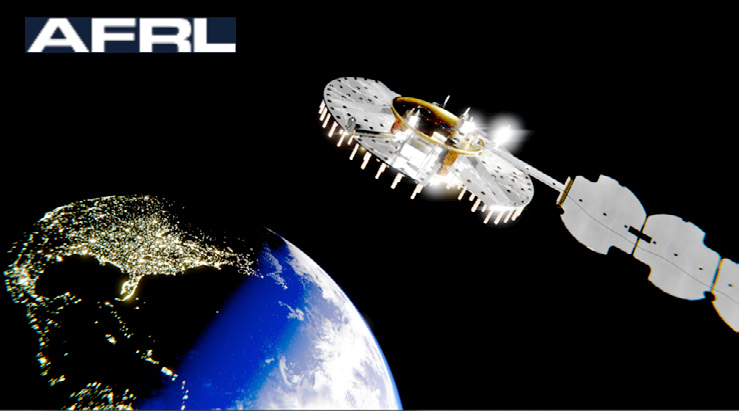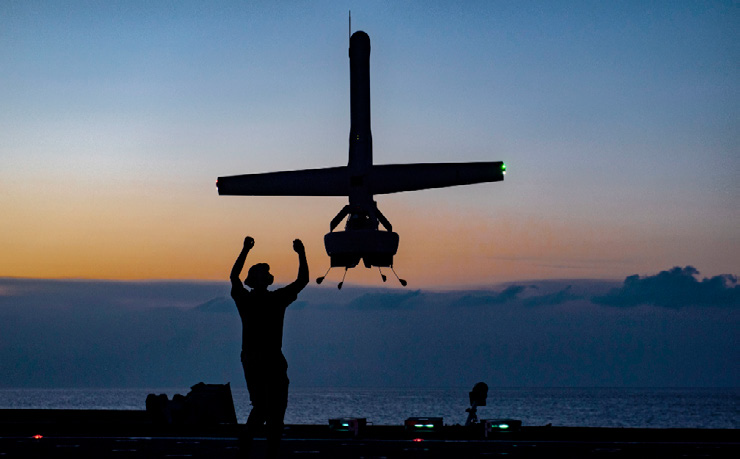SES Space & Defense awarded AFRL contract
SES Space & Defense, a wholly- owned subsidiary of SES that is focused on delivering satellite network solutions for the U.S. Government (USG), has been awarded a multi-year contract by the U.S. Air Force Research Laboratory (AFRL) to conduct a series of tests to integrate space broadband services across a multi-orbit satellite network in support of the Defense Experimentation Using Commercial Space Internet (DEUCSI) program.

This announcement by AFRL is the third award under the DEUCSI CALL 003 Program seeking experimentation for use cases in the Arctic region and airborne comms. The DEUCSI program is intended to establish communications with military platforms via multiple commercial space internet (CSI) constellations in GEO, MEO and LEO using a common, user terminal, with the ability to alternate between space broadband providers.
SES Space & Defense will demonstrate multi-orbit, multi- band solutions that seamlessly switch among commercial space broadband services in different frequency bands to access favorable spectrum or failover between constellations. In doing so, SES Space & Defense will leverage common hardware elements to communicate with commercial space broadband constellations and military communications systems to provide greater flexibility in communication paths while minimizing the deployment of constellation-specific hardware.

“An integrated, multi-orbit, multi- band satellite architecture is a requirement in today’s contested and congested environment for a network-centric military.
The DEUCSI program is a great example to showcase SES Space & Defense’s multi-orbit, multi-band holistic approach to deliver seamless interoperability to the U.S. Air Force to achieve unparalleled situation awareness and strategic advances for mission success.” — Jim Hooper, Senior Vice President of Space Initiatives, SES Space & Defense
Shield AI demos V-BATs with AFWERX
Shield AI has successfully completed an autonomous teaming demo that featured three V-BAT Unmanned Aircraft Systems (UAS) — this accomplishment was the final milestone of an AFWERX autonomy effort under their Strategic Funding Increase (STRATFI) program and collaboration with the AFRL Sensors Directorate.

Shield AI showcased their Hivemind AI pilot by launching a team of three V-BATs to monitor and surveil simulated wildfires. The multi-agent, coordinated team conducted Detect, Identify, Locate, and Report (DILR) missions in a contingency scenario with dual-use applications. This work with AFWERX sets Shield AI on a path to deploy V-BAT teaming capabilities in GPS- and communications-denied environments in the next year.
Hivemind can be trained for a variety of missions and its modular open systems architecture enables portability to other aircraft. It has flown quadcopters, V-BATs, and jet aircraft. Hivemind can be trained to undertake a broad range of missions, including integrated air defense breach, SCUD missile hunting, zone reconnaissance, counter-air, beyond-visual- range strike, maritime domain awareness, and communications- contested operations.
“Intelligent, affordable mass that can see everything on the battlefield, execute the mission even when GPS and comms are denied or degraded, and put all our adversaries’ military assets at risk at all times is the holy grail of deterrence. This milestone brings us closer to achieving that reality. We had many customers from across the DoD enterprise attend the event and my favorite customer quote was ‘Wait, you’re flying those three aircraft, doing the recon, and at the same time briefing us?!’ The customers genuinely appreciated that this isn’t merely talk, or just computer simulations, or a science project leading nowhere. This represents real autonomy on actual aircraft that, most importantly, will be deployed imminently.”
—Brandon Tseng, Shield AI’s President and Co-founder Shield AI (and former U.S. Navy SEAL)
“Autonomy on V-BAT directly supports our autonomy efforts on uncrewed jet aircraft. Beyond our autonomy stack being leveraged across different aircraft, what sets this autonomy effort apart from others is that it was deployed on a program- of-record aircraft and will be a fielded capability next year.
Many DoD-funded efforts, unfortunately, never reach the hands of a warfighter. However, Shield AI and AFWERX decided from the start that we would field this capability within the DoD. The great thing is all our DoD customers — the Army, the Navy, the Marines, SOCOM, and the Air Force — will benefit from this AFWERX effort. Autonomy is a joint capability,” — Ryan Tseng, CEO and Co-founder, Shield AI.
“What’s exciting to us is not just the capability that teaming V-BATs can bring to the table or how it’s on a great path for fielding with DoD partners, but how autonomy stacks can be leveraged across different aircraft and programs. The continual application of autonomy from small systems, now V-BAT, and onto larger platforms provides paths for industry progression and autonomy maturation. The criticality of autonomous capabilities for future programs of record within the DoD was the driver for this Shield AI – AFWERX effort.”
— Col. Tom Meagher, Prime Division Chief, AFWERX
Two scrubs for SpaceX... then... success for SDA smallsats
Following two scrubs, a SpaceX Falcon 9 rocket lifted off on schedule with 13 demo satellites for the U.S. Space Development Agency (SDA) at 7:25 a.m. PDT (10:25 a.m. EDT / 1425 UTC)7:25 a.m. PDT (10:25 a.m. EDT / 1425 UTC) on August 31st from Vandenberg Space Force Base.

The site’s location on the California coastline provides customers with access to high inclination and polar orbits, frequently used by satellite communication constellations, defense intelligence and Earth- observing satellites, and some lunar missions. Launches from Vandenberg head straight south and traverse open ocean all the way to the Antarctic, by which time the vehicles have long since reached orbit.
Following two scrubs, SpaceX launched on the third attempt with a batch of 13 communications and missile tracking satellites from Space Launch Complex 4 East (SLC-4E) at VSFB on the Tranche 0 Flight 2 mission for the Space Development Agency (SDA). An issue with engine 4 scrubbed the first attempt and a ground valve issue scrubbed the second attempt.
At the request of the SDA, SpaceX did not provide coverage of the second-stage portion of the flight. This is standard procedure for many national security missions.
The 13 demo satellites launched are for a future constellation of military missile tracking and data relay satellites. Ten satellites for the constellation were launched April 2 on a Falcon 9. Four more satellites are scheduled for launch on a later mission hosted by the Missile Defense Agency, according to an SDA fact sheet.
The Falcon 9 first-stage returned to successfully make a landing at Vandenberg VSFB.
This SDA mission was SpaceX’s 50th launch from Vandenberg. After conducting a total of 19 launches from SLC-4E from 2013 through 2021, the pace has picked up recently, with 13 missions in 2022 and 17 flights already completed in 2023. This launch came after SpaceX launched the company’s Starlink Group 6-13 mission.
SpaceX designs and builds its reusable rockets and spacecraft at its headquarters in Hawthorne, California. As a company, SpaceX is vertically integrated, building the vast majority of the vehicle on the Hawthorne campus.
All’s well that ends well…and it did.
RTX connects new platforms as battlefied nodes
RTX (NYSE:RTX) has demo’d advanced AI-enabled communications systems to rapidly distribute data to coalition partners during the second round of the U.S. Indo-Pacific Command’s Northern Edge 2023 exercise series at Kadena Air Base in Okinawa, Japan.

Collins Aerospace, an RTX business, expanded upon the airborne, platform-agnostic data hotspot that the company debuted during the first Northern Edge exercise in Alaska earlier this year.
Leveraging the company’s cross domain solution, advanced AI-enabled communications, and intelligent gateway technology, Collins connected partners from The Five Eyes alliance and others to the data network, expanding joint force capabilities during the demonstration.
RTX’s Raytheon business unit contributed to accelerating decision-making timelines, with an integrated team demonstrating how AI-enabled machine-to- machine communications rapidly delivered threat awareness data from the U.S. Space Force’s Unified Data Library to multiple aircraft, demonstrating how they can be used as connectivity nodes on the battlefield.
RTX’s suite of technologies is flexible, allowing integration into a variety of platforms. The company’s focus on open systems architecture development aims to support the evolving needs of the customer and the battlefield and its technologies enable synchronized operational capabilities available in every domain.
Expanded connectivity to U.S. Air Force Mobility Command assets was facilitated through an ongoing Cooperative Research and Development Agreement (CRADA) between Collins Aerospace and the Utah Air National Guard. The agreement is focused on extending the utility and survivability of the KC-135 by expanding the role the KC-135 can play on the battlefield as an airborne refueling and connectivity node.
“This was a critical demonstration to prove our solutions can facilitate and enable connectivity for a large and growing joint force network,” said. “It’s important to understand that the joint fires data our systems processed and distributed came from
a large network of platforms that weren’t originally designed to connect and share data like this. Not only did our gateway and cross domain solution connect those platforms, they also automated the distribution of that data to the right partner at the right security level.” — Elaine Bitonti, Vice President, Connected Battlespace & Emerging Capabilities, Collins Aerospace
“Our automated communications powered by AI securely provided mission data to a number of platforms including C17s, C-130s and the KC-135 in a realistic combat scenario. Northern Edge TAC- 2 has been a vital proving ground to demonstrate how enabling JADC2 technologies can strengthen the Joint Force and its allies and partners’ readiness to fight and win.” — Conn Doherty, vice president of Battle Management Command & Control & Autonomy Solutions at Collins Aerospace.
USSF awards Viasat contract for pLEO satellite services
Viasat, Inc. (NASDAQ: VSAT) has announced that Inmarsat Government, now part of Viasat, was awarded a Proliferated Low Earth Orbit (PLEO) Satellite- Based Services (SBS) contract by the U.S. Defense Information Systems Agency (DISA) on behalf of the U.S. Space Force’s (USSF) Space Systems Command (SSC) — Inmarsat Government is one of 16 companies selected for the $900 million ceiling, 10 year, Indefinite Delivery, Indefinite Quantity (IDIQ) contract.
Proliferated LEO (pLEO) constellations are part of a Department of Defense (DoD) strategy to provide additional resilience for satellite communications (SATCOM), remote sensing and other capabilities by diversifying orbits.
Viasat plans to leverage smallsat technology, reduced costs and increased launch service competition, facilitating the ability for pLEO constellations to provide persistent, global coverage with reduced transmission latency. The company will provide a suite of fully-managed pLEO satellite-based services and capabilities, to include space relay services, supplemented by GEO and NGSO satellites, supporting all domains – space, air, land, maritime and cyber.
Viasat will aim to achieve this with a reliable, resilient low latency global pLEO offering that flexibly supports the needs of combatant commands, defense agencies, other federal government organizations and international coalition partners. It will provide a comprehensive managed end-to- end SATCOM solution via a multi- band, multi-orbit constellation of satellites. Furthermore, its new, hyper-intelligent software-defined wide area network (SD-WAN) is designed to orchestrate and provide priority routing across mixed networks, enabling an automated primary, alternate, contingency and emergency (PACE) solution to deliver the flexibility and responsiveness required to meet customers’ needs today and in the future.
IARPA launches micro space debris tracking program
The Intelligence Advanced Research Projects Activity (IARPA) — the advanced research and development arm of the Office of the Director of National Intelligence — has launched a program that aims to revolutionize the nation’s ability to detect, track, and characterize miniature, orbital, space debris.
The Space Debris Identification and Tracking (SINTRA) program represents the Intelligence Community’s first effort to track small space debris. Resulting technologies hold the potential to protect manned spacecraft and other valuable space assets from these compact threats, which are difficult to detect and track and can cause significant damage, making space missions safer for all countries and industries using Earth’s orbit.
SINTRA aims to create innovations that…
• Bridge gaps in current space debris-monitoring systems, which currently only track and monitor debris greater than 10 cm in size or model the distribution of debris less than 1 mm in size
• Enhance small debris- tracking capabilities with existing sensors, such as ground-based radar, tracking satellites, and optical sensors.
Through a competitive Broad Agency Announcement, IARPA awarded SINTRA research contracts to four, prime contractors, which together with sub-contractors, bring a group of 12 academic and private-sector organizations into the program. The SINTRA program is anticipated to be a four-year effort.
“The global economy, telecommunications, and security rely on constant satellite connectivity,. Discovering new ways to understand the millions of man-made debris objects orbiting the earth, especially since they are ever-increasing in number, has never been more critical to everyday life.”
—Dr. Alexis Truitt, Program Manager, SINTRA



